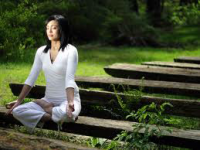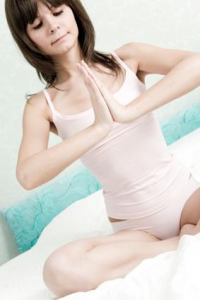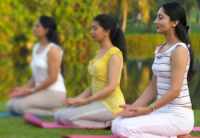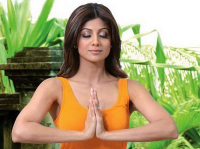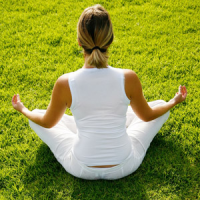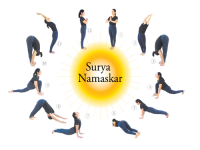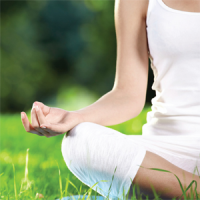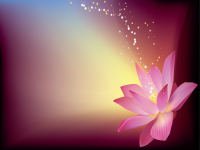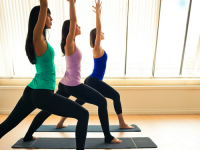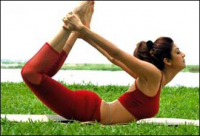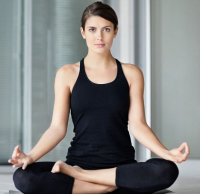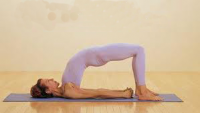Yoga For Hypertension Yoga has always been advised to people with High Blood Pressure, because as soon as the person adopts an asana (posture) his life pattern changes. The personality and diet will change and becomes a puritan. Performing asanas, a person will not want to smoke, will not eat a full lobster. Yoga is a combination of psychoanalysis, psychiatry and physiotherapy, keeping the blood pressure as normal as possible. Yoga For Hypertension patients gives them spontaneous energy and good things start happening to the person. Besides, yoga also clears the brain and the person performing yoga understands what he was doing and can thus correct himself as he always emanates positive energy. Yoga is a way of life and it treats a person as one with soul. It helps bring down the high blood pressure and many related disease that may occur due to having high blood pressure. Yoga For Hypertension works as it is both a static and dynamic exercise and improves the cardiovascular efficiency in a healthy as well as a sick person. Yoga For Hypertension patients includes Pranayama and Savasana, which are important yogic methods to control the blood pressure. Pranayama or breath control, conscious respiration, savasana were a person adopts a dead-body-like posture and starts relaxing from the toes to the upper part of the body step by step are some yogic postures that can remove the stress and control blood pressure
Definition of Yoga యోగ అంటే అదృష్టం, కూడిక, కలయిక, సంబంధం, ధ్యానం, ఇలా ఎన్నో అర్థాలు యోగకు ఉన్నాయి. అదృష్టం అను అర్థంలో యోగ శబ్దాన్ని వాడుతూ యోగం బాగుండటం వల్ల ఇంతవాడు అంతవాడు అయినాడని అంటూ ఉంటారు పెద్దలు. కూడిక అను అర్థంలో యోగ శబ్దాన్ని వాడుతూ ఒకటి ప్రక్కన సున్నా చేరిస్తే పది, పది ప్రక్కన ఆరు చేరిస్తే పదహారు, నాలుగు నాలుగు కలిపితే ఎనిమిది, ఎనిమిది అయిదు కలిపితే పదమూడు అని అనడం మనకు తెలుసు. కలయిక లేక సంబంధం అను అర్థంలో యోగ శబ్దాన్ని వాడుతూ తల్లి - కొడుకు, తల్లి - కూతురు, తండ్రి - కొడుకు, తండ్రి - కూతురు, భార్య - భర్త, అత్త - కోడలు, గురువు - శిష్యుడు అని అంటూ వుంటారు. మరికొంచెం మనం ముందుకు వెళ్లి ఆత్మ - పరమాత్మల కలయిక కోసం చేసే ప్రయత్నాన్ని ధ్యానం అని అంటారు. ఇది ఏకాగ్రతపై ఆధారపడి ఉంటుంది. దీనికి విశ్వాసం, నమ్మకం చాలా అవసరం. యోగ శాస్త్రంలో ధ్యానం ఒక ప్రధానమైన అంశం. ధ్యానం దేని కోసం అని అడిగితే ఆత్మ పరమాత్మల కలయిక లేక ఆత్మ సాక్షాత్కారం కోసం అని సమాధానం లభిస్తుంది మనకు. ఇది సాధ్యమా అని అడిగితే చిత్త ప్రవృత్తుల్ని, ముఖ్యంగా కామ, క్రోధ, లోభ, మోహ, మద, మాత్సర్యాల్ని జయించగలిగితే సాధ్యమేనని సమాధానం లభిస్తుంది. యోగ శాస్త్ర ప్రణేత పతంజలి మహర్షి మాటల్లో యోగాశ్చిత్త వృత్తి నిరోధ: అంటే చిత్త ప్రవృత్తుల నిరోధమే యోగ అన్నమాట.
Hot Yoga at Home Are you a fan of hot yoga.Hot yoga is believed to help the body sweat out toxins while allowing the practitioner to safely come deeper into asanas.In the various forms of hot yoga, the room is heated to warm the muscles and induce sweat. Hot yoga can help improve range of motion, prevent injuries, and help heal from previous injuries. The heat increases the pulse and the body burns more calories in its efforts to stay cool while exercising. Heat dialates capillaries, distributing oxygen more effectively to muscles, glands, organs and other tissues, helping to remove toxins. Hot yoga can also assist with weight loss, exercise and stress reduction – all in one session. You don't need a large room in order to be able to practice hot yoga at home. You'll only need a space large enough for your mat, with a few feet in each direction beyond it. The smaller the room you choose, the less energy and time the room will take to heat up to the desired temperature. Many yogis use space heaters to get a room of their house appropriately hot for the practice. The amount and type of space heaters needed depends on the size of the room, the insulation, the outside temperature, and the output of the space heater(s). Many people in Florida and in the Southwestern states practice Hot Yoga on their patios or beside the pool! If you live in a colder climate, you'll want to choose the smallest and best insulated room possible. In order to create a nice, hot environment, try using a humidifier alongside a space heater. In addition, you can use essential oils or scented candles to help improve the atmosphere of the room. Many practitioners who do Hot Yoga at home maintain that the best room of the house for the practice is a large bathroom. While it may seem like a waste of warm water, running a hot shower or having a bathtub full of hot water will heat and steam up the room. The only way to find out which temperature and humidity level make your ideal Hot Yoga environment is to try a bunch of different combinations and see how each one feels. Be sure to try each combination a few times on various days so that you don't wrongly interpret your ideal environment as awful simply because you were overtired or stressed the particular day that you tried it for the first time. As there will be no instructor to remind you, make sure you drink lots of water before, during, and after each hot yoga session to avoid dehydration.
Yoga Tips However, performing Yoga requires a person to follow some specific guidelines, in order to achieve best results. There are various do's and don'ts that a person needs to follow before, while and after performing Yoga. To know more about Yoga practicing guide, browse through the following lines. * Yoga must energize and not cause weariness and depression. * You must take breaks in between, if a particular step or exercise proves tiring. * Over eating and fasting should be avoided. At the same time, you must try to avoid stale food. * Remember, to start with your movements should be light and if you feel fatigue in between you must discontinue. * For a person performing Yoga, the diet should be a balanced and you should eat after an interval of 4 hours. * The most appropriate time for practicing Yoga is in the morning, before breakfast. This is because it is the time, when our mind is calm, composed and fresh and the body movements can be performed, with considerable ease and vigor. * To get started, you need to have the urge and confidence in yourself. * To practice Yoga, the place chose must be calm, quiet, ventilated, dust free, moisture free and also distraction free. * Remember, you need to always begin with the easy postures and then, proceed to the difficult ones. You should follow the graded steps of Yoga. * Before you start practicing Yoga, it is very important for you to clear your bowels and bladder as well as clean your nostrils and throat of all mucus. You must also drink a glass of lukewarm water. * Yoga clothing should be loose and as comfortable as possible. Form-fitting cotton/Lycra pants and shirts are the best. Wait for a few minutes and then you can start. * Like all other work outs, you must begin with easy poses, thereafter you can advance to the tough ones. Be methodical and systematic. * You should always keep a Yoga mat, made of some comfortable materials. For lying postures use a woolen carpet and spread a clean sheet over it.
Yoga Benefits For Eyes Most of us do not exercise our eye muscles at all, but yet, we work them all the time, causing them to be under constant strain. The only time the eyes rest for more than a split second, is when we are asleep. * Light a lamp/candle at a distance of two feet at the eye level. Stare at the bluish centre of the flame with a steady gaze. Continue staring, even if the eyes start watering. * You can do this for about 10 minutes to begin with, and slowly increase the duration until the time you feel comfortable. * Then slowly get up and fill your mouth with water. Keeping this water in your mouth, wash eyes with tap water. * Then spit the water out. This water will be warm as heat gets released from the body. This has to be done twice or until the water temperature gets normal. This is a must after this particular kriya. * Look to your right as far as you can, being aware of the edge of your visual field. Hold for 3 seconds, then release. Repeat again, but looking to your left. Hold for 3 seconds, then release. Repeat left and right 3 times. * Sit comfortably on a straight-backed chair, with your legs uncrossed and hands resting lightly in your lap. Keep your chin level and move only your eyes, neither your head nor neck. * Breathe gently and evenly throughout the sequence. Don’t stain nor force any movements: go only as far as is comfortable. Close your eyes to relax at the end. * Sit comfortably with your eyes open. Blink around 10 times very quickly. Close your eyes and relax for 20 seconds. Slowly take your attention to your breath. * Repeat this exercise about 5 times. * Rub your palms together and gently cup them over your closed eyes for around a minute. This is known as palming and is very beneficial for the eyes. * The eyes need darkness to rejuvenate them and this need is best served by palming. Palming should be done after every eye exercise, to relax the eyes and every now and then during the day.
Yoga and Mental Health The benefits Yoga bring, let us define what mental health is. Mental health is human ability to face and solve problems and select the correct alternative that results in happiness of mind. * Yoga asanas aid in healing the problem after treatments like psychotherapy and some anti-anxiety medication. Yoga helps one develop a stronger state of mind, thus overcoming fears and preventing the dangers of anxiety. Asanas assisting nervous system should be practiced in this stage. * Depression is continuous stage of mental sadness.It could have serious symptoms like being fatigued physically and mentally, change in appetite, feeling of intense fear or melancholy, irritability, loss of interest in usual activities, changes in sleeping patterns, feelings of guilt and hopelessness, hallucinations, and recurring thoughts of suicide or death. *Yoga is handy in curing one of this problem. You can practice Yoga as a supplement to the treatment. It helps reduce stress and creates a peaceful state of mind. * Yoga postures are developed to promote physical strength, flexibility and balance. Any Yoga posture has cardio/heart benefits associated with it. *Heart rate is frequently up while performing these postures. Between various yoga postures, you also get rest periods. So practicing Yoga postures becomes much easier than doing conventional exercise. * Yoga philosophy teaches us not to be depressed in frustrations. Several Yogic theories are important in this regard. * Yogic exercises divert one's attention from frustrating experiences. Yoga has several methods of tackling mental disorders.
Beauty Through Yoga * The first and foremost principle of Yoga is that until you do not feel good, you can't look good. Thus yoga through its asana like Sukhasna and Shavasana aims to provide complete relaxation to your body. * Yoga helps you gain physical fitness, helps in the healthy maintenance of mind and body. It also acts in removal of toxins from the body and increases flexibility of your body making you look younger. * Yoga helps improve the efficiency of the immune system. Through regular Pranayams like Kaplabhati and Anulom- Vilom, you can easily avoid little daily problems of health. * Yoga is equally active in thyroid and weight loss leading to perfect shaping of the body and thus making you beautiful. * The perfect oxygen dose which we get through various Yoga Asanas and Mudras also helps in skin glow. * Regular yoga brings contentment in your life which reflects on your face. * Yoga helps you in delaying ageing. A regular yoga practitioner remains young and active for quite longer than others who do not practice yoga.
Tips For Practicing Yoga Yoga brings stability and relaxation to the mind and helps the individual to have a clear thinking. Apart from its cognitive benefits, Yoga serves as the best medium to enhance the beauty and the being of a person. * The most appropriate time for practicing Yoga is in the morning, before breakfast. This is because it is the time, when our mind is calm, composed and fresh and the body movements can be performed, with considerable ease and vigor. * Get started, you need to have the urge and confidence in yourself. * To practice Yoga, the place chose must be calm, quiet, ventilated, dust free, moisture free and also distraction free. * Before you start practicing Yoga, it is very important for you to clear your bowels and bladder as well as clean your nostrils and throat of all mucus. You must also drink a glass of lukewarm water. * Yoga clothing should be loose and as comfortable as possible. Form-fitting cotton/Lycra pants and shirts are the best. * Wait for a few minutes and then you can start. * Like all other work outs, you must begin with easy poses, thereafter you can advance to the tough ones. Be methodical and systematic. * Remember, to start with your movements should be light and if you feel fatigue in between you must discontinue. * Must energize and not cause weariness and depression. * You must take breaks in between, if a particular step or exercise proves tiring. * A person performing Yoga, the diet should be a balanced and you should eat after an interval of 4 hours. * The quantity of food should be such that it satisfies your appetite. Generally, the ratio composition of meals should be - grains and cereals (30% of the calorific value), dairy products (20%), vegetables and roots (25%), fruits and honey (20%) and nuts (5%). Over eating and fasting should be avoided. At the same time, you must try to avoid stale food. * While performing Yoga, your breathing should be long and deep. You must remember to keep your mouth close and inhale and exhale, only through the nose. * You should always keep a Yoga mat, made of some comfortable materials. For lying postures use a woolen carpet and spread a clean sheet over it. * Remember, while doing yoga, you should not get a feeling of pain or discomfort. If you do, you are not doing it in the right manner or you need to adjust your pose to suit you better. * You are a beginner, do not just impinge on doing the tough tasks. Remember, you need to always begin with the easy postures and then, proceed to the difficult ones. You should follow the graded steps of Yoga.
Laughter Yoga Benefits laughter is the best medicine, Laughter Yoga is one of the best forms of yoga. Just moments after joining in a Laughter Club you will begin to laugh freely without hearing or telling jokes. This is called unconditional laughter. Healthy Benefits of Laughter Yoga 1) It lowers stress 2) It strengthens the heart 3) It boosts the immune system 4) It improves digestion and elimination 5) It releases endorphins, which are natural pain killers.
Benefits of Surya Namaskar Surya namaskara is a series of twelve physical postures.Surya Namaskar has a deep effect in detoxifying the organs through copius oxygenation and has a deeper relaxing effect. Benefits of Suryanamaskar. * Strengthens abdominal muscles. * Tones up the digestive system by the alternate stretching and compression of abdominal organs. It activates digestion and gets rid of constipation and dyspepsia. * Revives and maintains the spirit of youthfulness. * Helps reduce fat. * Tones up the nervous system and improves memory. * Women, stimulates the breasts to help firmness normally. Restores any lost elasticity, through stimulation of glands and the strengthening of pectoral muscles. * Suppresses menstrual irregularity and assists in easy childbirth. * Broadens chest and beautifies arms. * Produces health, strength, efficiency and longevity. * Thoroughly ventilates the lungs, and oxygenates the blood. * Acts as detoxifying agent, by getting rid of enormous quantity of carbon dioxide and other toxic gases. * Promotes sleep and calms anxiety. * Normalizes the activity of the endocrine glands - especially the thyroid gland. * Refreshes the skin. Prevents Skin disorders. * Improves muscle flexibility. * Prevents loss of hair and graying. * Reduces abnormal prominence of the Adam's apple. * Eliminates unpleasant smells from the body. * Lends grace and ease of movements to the body. * Makes the spine and waist flexible.
6 Yoga Poses for Depression and Anxiety Yoga is really about calming the mind through a combination of breathing and physical poses. the ancient Indian word for the union of mind and body.names of the various asanas or poses are in themselves indications of the purpose they are supposed to fulfill. 6 Yoga Poses for Depression and Anxiety 1 Child pose or balasana is perhaps the most comforting yoga pose. "It can bring groundedness and humility and quiet to the body," says Elena Brower, who owns Manhattan's Virayoga. For those suffering from anxiety, it can create peace and silence. 6 Yoga Poses for Depression and Anxiety 2 A forward bend, or uttanasana, where you bend forward and reach for your toes and bring your head close to your knees, is, according to Brower, "really good for generating a contemplative, connecting state in us." 6 Yoga Poses for Depression and Anxiety 3 Legs up the wall or viparita karani, where you rest your legs against a wall, is a great pose for groundedness. "It's really good for insomnia, great for bringing you back to the present moment and re-routing circulation," says Brower. 6 Yoga Poses for Depression and Anxiety 4 Cat pose or marjariasana, the multi-step asana that resembles the stretching of a cat, helps with relaxation. "It is good for bringing awareness to the breathing which is usually in short supply when one is anxious. it can soften and slow down the process of being anxious," says Brower. 6 Yoga Poses for Depression and Anxiety 5 Backbends are usually quite advanced and can be very stimulating. However, Brower recommends a back bend done over a roll. It can help you open up the heart and free up the energy that's blocked there," she says. 6 Yoga Poses for Depression and Anxiety 6 Headstands or shirshasanas are well known for their ability to increase circulation to the brain and reduce anxiety and insomnia. However, says Brower, it is only meant for advanced practitioners.
Yoga for a Beautiful Body Awkward Chair Stand with feet together and abs contracted. Exhale as you push your hips back to squat down as if sitting in a chair; at the same time, lift your arms by your ears. Arms should be shoulder-width with palms facing and fingers pointing toward the ceiling. Hold for 5 to 8 breaths. High Lunge Keeping arms raised and abs tight, step your left foot back and lower into lunge position so front knee is bent at 90 degrees and directly over your ankle. Hold for 5 breaths. Plank Lower your hips, coming onto your toes and moving your torso forward until your shoulders are directly over your hands. Your abs should be tight, with your body in a straight line from head to heels. Hold for 5 breaths. Low Plank Keeping your body in line, inhale and bend your elbows to 90 degrees to lower yourself toward the floor. Hold for 1 breath. Half Moon Return to center and drop your right hand to the floor about 10 inches diagonally in front and outside of your right foot. Raise your left arm, pointing fingers toward the ceiling as you straighten your right leg and lift your straight left leg into the air, foot flexed and pointing to the side; look up at your left hand. Hold for 5 breaths.
Physical Yoga Benefits Pain Reduction Most of the yoga postures helps in relieving stress, tension and muscle soreness. Practicing yoga regularly strengthens the immune system, prevents illness, improves flexibility and it makes you feel comfortable with your body. Improved Breathing Deep breathing yoga exercises makes the body more alkaline and less acidic. High acidity in body causes bone and tissue damage, arthritis, fatigue, stress and headache. Blood Circulation Improved When blood circulation increases it removes the body impurities and it eliminates toxins. Doing yoga regularly keeps the blood pressure down and also the pulse rate.
Benefits of Yoga in Everyday Life The practice of yoga, as well as giving all those attributes that are well known, can also give many helpful benefits in everyday life that do not necessarily belong to the field of yoga. * Yoga can help cure insomnia, as regular yoga practice leads to better and deeper sleep. * Yoga can help fight fatigue and maintain your energy throughout the day. * Yoga is an effective treatment for a variety of autoimmune diseases because it can reduce the symptoms these diseases often cause, such as stiffness, malaise, fatigue, and weakness.
Improve Your life Style with Yoga This year's New Year resolutions, worldwide, made by people from different countries and cultures, had one common thread. They wish to improve the quality of their lives through concerted effort, and so they resolved to pursue a more healthy lifestyle. Overwork, stress, erratic lifestyle without thought to structure, and a sedentary way of life have all contributed to ill health and in some cases, even poor self-esteem. How can all these problems be resolved?
Stop Smoking with Yoga Yoga postures help stop smoking! Yoga positions and yoga postures have a ton of benefits to physical, emotional, and spiritual health; and it can be a wonderful holistic healing method of quitting smoking. Not only are there essential breathing techniques with yoga that help smokers’ lungs recovery more efficiently, the yoga poses themselves are highly conditioning exercises that work wonders for the body. Ustrasana – Camel Pose Instructions Instructions 1. Come up onto your knees. Take padding under your knees if they are sensitive. 2. Draw your hands up the side of your body as you start to open your chest. 3. Reach your hands back one at a time to grasp your heels. 4. Bring your hips forward so that they are over your knees. 5. Let your head come back, opening your throat. Dhanurasana -Bow Pose Instructions • Lie flat on the floor with the abdomen, chest and chin touching the ground. • Keep your hands on both sides. • Keep both legs a bit apart. • Relax your whole body. • Bend your legs backward and grasp the ankles firmly with your hands. • First raise your chin and then bend your head and neck backwards. The chest should still be touching the ground. • Inhale slowly and pull your legs up. • Keep raising your head, neck, chin, chest, thighs and knees backwards, such that only the navel region is touching the ground • Balance your body on the navel region. • Pull your legs and arms arching your body as much as possible. • Gradually, bring your knees, feet and toes together. • Look up and fix you gaze on the ceiling. • Holding your breath maintain this posture until you feel the strain in your back. • Start exhaling slowly and gradually return to the starting position. These aspects are crucial to the connection of yourself and smoking and will center you and help your body come to the realization smoking is not healthy. Savasana - Corpse Pose Instructions • First of all, sit flat on the ground, with your back straight and your legs stretched out in the front. • Bend your knees lightly and then gradually lean back onto your elbows, in the process lying down evenly along your spine. • When your back is parallel to the floor, straighten out the legs as well. Moving one of the legs at a time, carefully place them on the floor. Try to place your legs the center of the back of the thighs and calves. • Start to relax slowly, first letting your feet fall out to the sides and then, turning your arms outwards. Rest the arms, on your sides, in such a way that the palms face up. • Stretch the back of your neck and try to rest your head on the center of the back of the scull. • Now, draw your shoulders away from your ears and let them fall back in a comfortable position. • Close your eyes and take several deep breaths, feeling your body become relaxed and the tension go away. • Let go of your body completely and allow your breath to become soft, regular and quiet. • Aiming at one of the parts of your body, let it begin to relax and then move to the other parts. • At the end of the asana, stop relaxing consciously and let you body remain in the peaceful mode, for a few minutes. Give yourself to yoga. Try it. Nothing you lose – other than a nasty habit? You’ll gain much more in the process. Not only will you find yourself again, but you’ll discover a confidence and fresh attitude that was lost in a sea of smoke.
Pimple Treatment with Yoga Yoga is the ancient Indian tradition of body and mind fitness. Its aim is to harmonize the body, mind and spirit through a series of postures, breathing techniques and meditation. These postures are movements and stretches that when combined with breathing exercises prove very beneficial for the body. Especially Sarangasana, Matsyasana and Kapola shakti Vikas are the most beneficial yoga poses to remove Pimples. Instruction for Sarvangasana Lie down on the floor on your back, legs together and arms on the sides. Turn the palms down. Relax your body and continue normal breathing. Press your palms and elbows on the floor and raise your legs up making an angle of 90 degrees with the floor. Inhale as you raise your legs. Exhale and while exhaling move your legs towards your head and push your hips and lower back so that they are raised above the ground. Place your palms on the hips and push your trunk and legs up. Move your palms higher up the trunk and keep raising your legs and hips upwards, till the whole trunk is above the ground. Bring the legs back to a vertical position. Support your body with the palms placed on the ribs and elbows and forearm resting on the ground. Sliding the palms higher on the trunk push the hip and back further up so that they are aligned with the legs. At this point, only the head, neck and shoulders should be on the floor. Push your face down and chest up to form a chin lock. Balance your body in this position. Fix your gaze on the big toes of your feet. Inhale and exhale rhythmically and remain in this posture for as long as you can. Slowly return to the starting position in the reverse order. Inhale deeply and exhale slowly a few times. Continue breathing normally. Relax your body by performing Savasana. Instructions for Matstyasana Sit in Padmasana and make the feet lock properly. Your knees should be touching the ground. Lean back slowly, taking the support of your elbows. Lie flat on your back. Bring back both your hands and place them near the head with palms resting on the floor. Place the palms under the corresponding shoulders. Taking the support of your palms and knees, push your chest and abdomen up. Raise your hips, back and shoulders from the ground. Arch your spine and now bend your head and neck backward to the maximum limit. Try to place the crown of your head perpendicular to the floor. Remove the support of your hands. Bring the hands forward to hold the upper thighs. Increase the arch of your body with the help of your elbow for support. Extending your hands further now grasp the big toe of the opposite legs and form a lock with the thumb, index and middle finger. Remain in this posture for 10 seconds. 16. Take deep breaths rhythmically. 17. Release your toes and slowly return to Padmasana posture. Instructions for Kapola Shakti Vikas Sit down in padmasana and relax Iinhlae with the mouth and hold the air tightly as shown in the video. Close your nose with your fingers. and hold for some time. Then slowly exhale with the mouth. Do this for atleast 5 times a day.
Fat Burn Yoga Poses There are a lot of things possible today and depending upon the way you look at it. It is also a fact that the fat is a great health hazard - particularly indicating cardiac problems. Most of the people who suffer from this malady would be in high danger of heart attack and paralytic strokes. Weight loss isn’t easy for anyone but, with the right attitude, you can make a real difference in how you look and feel. Here are few fat burn yoga poses which keeps you not only fit but make your figure perfect. Paschimottanasana pose - Bent Knee Trunk Flexion Sit on the floor, then with legs stretch legs straight and palms on the floor by the sides of the hips. Deeply inhale and while exhaling bend forward and hold the big toes by corresponding hands, and keep the face on the knees. Take a few normal breaths. And now inhale come up, release the hands and be in normal sitting posture. Doing this at least for four times will give you a good result. Dhanurasana - The Bow pose Instructions for Dhanurasana – bow pose Lie flat on the floor with the abdomen, chest and chin touching the ground. Keep your hands on both sides. Keep both legs a bit apart. Relax your whole body. Bend your legs backward and grasp the ankles firmly with your hands. First raise your chin and then bend your head and neck backwards. The chest should still be touching the ground. Inhale slowly and pull your legs up. Keep raising your head, neck, chin, chest, thighs and knees backwards, such that only the navel region is touching the ground Balance your body on the navel region. Pull your legs and arms arching your body as much as possible. Gradually, bring your knees, feet and toes together. Look up and fix you gaze on the ceiling. Holding your breath maintain this posture until you feel the strain in your back. Start exhaling slowly and gradually return to the starting position. Bridge Pose – setu bandha sarvangasana Lie on your back with your knees bent, feet together. Keep your arms on your side, palms on the floor. Lift the hips towards the ceiling, keeping your feet and palms flat on the floor. Maintain your position in Step 2 and move your arms over your head. Cat Pose – Bidalasana Start on your hands and knees. Position your hands directly beneath your shoulders and your knees directly beneath the hips. Have your fingers fully spread with the middle fingers pointing straight ahead. Make your back horizontal and flat. Gaze at the floor. This is your "neutral" positioning. When your pelvis is in neutral, your spine will be at full extension, with both the front and back sides equally long. As you wait for the inner cue, do not sag into your shoulders. Instead, create a line of energy through each arm by pressing downward into your hands and lifting upward out of your shoulders. Go back and forth like this several times to make sure you understand the movement. As you exhale, sag into your shoulders and do the incorrect action; as you inhale, lengthen the arms, lift out of the shoulders and do the correct action. When you are ready to begin, breathe in deeply. As you exhale, turn your hips into Cat Tilt. Do this by gently pulling the abdominal muscles backward toward the spine, tucking the tailbone down and under, and gently contracting the buttocks. Press firmly downward with your hands in order to stay lifted out of the shoulders, and press the middle of your back toward the ceiling, rounding your spine upward. Curl your head inward. Gaze at the floor between your knees. Cobbler Pose - Baddha Konasana Sit in a cross-legged position. Slowly uncross your knees and extend them out to the sides. Press the soles of your feet together. Bring your heels to your pelvis as close as is comfortable, keeping the outer edges of the feet firmly on the floor. Grasp your ankles. Inhale and draw back your shoulder blades. Lengthen the front torso by raising your sternum gently upwards. Exhale and tip the bowl of your pelvis forward, while keeping your spine extended. Maintain this pose for several long, deep breaths (1 to 2 minutes). Push your feet towards each other, so that your knees extend away from each other, freeing up space in the hips and belly. Inhale. Exhale and tilt the bowl of your pelvis backwards. Return your legs to Step 1.




